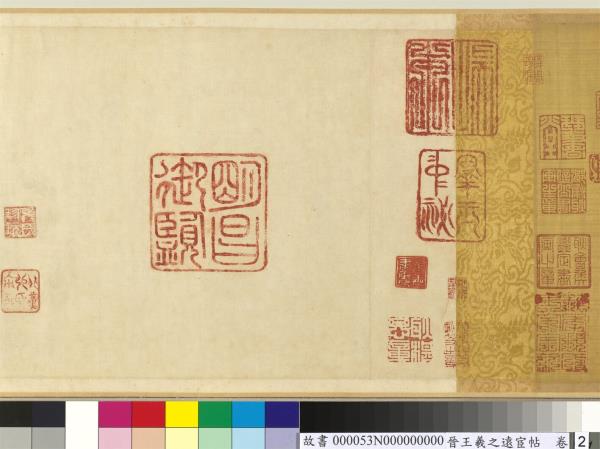| 文物統一編號 |
故書000053N000000000
|
| 作品號 |
故書00005300000 |
| 品名 |
晉王羲之遠宦帖 卷
Yuanhuan |
| 分類 |
法書 |
| 作者 |
王羲之,Wang Xizhi |
| 書體 |
草書 |
| 數量 |
一卷 |
| 作品語文 |
漢文 |
| 釋文 |
省別。具足下小大問。為慰。多分張。念足下懸情。武昌諸子。亦多遠宦。足下兼懷。並數問不。老婦頃疾篤。救命。恆憂慮。餘粗平安。知足下情至。 |
| 位置 |
尺寸(公分) |
| 拖尾 |
24.6x81 |
| 本幅 |
24.8x21.5 |
| 隔水一 |
4.8 |
| 隔水四 |
5.5 |
| 隔水二 |
5.8 |
| 隔水三 |
6 |
| 印記類別 |
印主 |
印記 |
| 收傳印記 |
宋徽宗 |
大觀 |
| 收傳印記 |
項元汴 |
子京所藏 |
| 收傳印記 |
項元汴 |
子孫世昌 |
| 收傳印記 |
耿昭忠 |
丹誠 |
| 收傳印記 |
耿昭忠 |
公 |
| 收傳印記 |
安岐 |
心賞 |
| 收傳印記 |
張金界奴 |
北燕張氏寶藏 |
| 收傳印記 |
耿嘉祚 |
半古軒書畫印 |
| 收傳印記 |
安岐 |
安儀周家珍藏 |
| 收傳印記 |
宋徽宗 |
和 |
| 收傳印記 |
金章宗 |
明昌御覽 |
| 收傳印記 |
耿昭忠 |
信公珍祕 |
| 收傳印記 |
耿昭忠 |
信公珍賞 |
| 收傳印記 |
耿昭忠 |
信公鑒定珍藏 |
| 收傳印記 |
宋徽宗 |
宣 |
| 收傳印記 |
宋徽宗 |
宣和 |
| 收傳印記 |
賈似道 |
秋壑圖書 |
| 收傳印記 |
項元汴 |
神 |
| 收傳印記 |
耿嘉祚 |
耿湛恩章 |
| 收傳印記 |
耿嘉祚 |
耿會侯鑒定書畫之章 |
| 收傳印記 |
耿嘉祚 |
耿嘉祚 |
| 收傳印記 |
張金界奴 |
張氏珍玩 |
| 收傳印記 |
耿昭忠 |
都尉耿信公書畫之章 |
| 收傳印記 |
耿嘉祚 |
湛恩記 |
| 收傳印記 |
耿昭忠 |
琴書堂 |
| 收傳印記 |
耿昭忠 |
琴書堂印 |
| 收傳印記 |
項元汴 |
項子京家珍藏(重一) |
| 收傳印記 |
項元汴 |
項元汴印(重一) |
| 收傳印記 |
項元汴 |
項墨林父祕笈之印(重一) |
| 收傳印記 |
項元汴 |
項墨林鑑賞章 |
| 收傳印記 |
耿嘉祚 |
會侯珍藏(重一) |
| 收傳印記 |
金章宗 |
群玉中祕 |
| 收傳印記 |
元內府印 |
端本 |
| 收傳印記 |
安岐 |
儀周珍藏 |
| 收傳印記 |
安岐 |
儀周鑒賞 |
| 收傳印記 |
項元汴 |
墨林 |
| 收傳印記 |
項元汴 |
檇李項氏士家寶玩 |
| 作者印記 |
項元汴 |
品 |
| 類別 |
參考資料 |
| 內容簡介 |
王羲之(303-361)此帖亦稱〈省別帖〉,為雙鉤廓填本,先以墨線勾勒輪廓後加以填墨,是古代法書複製中最逼真的方式,有「下真跡一等」之說。前黃絹隔水有宋徽宗瘦金書題及印記,曾著錄於《宣和書譜》,亦有金章宗及元、明、清諸收藏印。受信者為益州刺史周撫(293-365),是羲之晚年所作。傳世唐《十七帖》亦收此札,然較呆板且缺乏筆法的細緻變化,已失羲之原貌,遠不如此雙鉤墨蹟本的傳神。(20081012)
|
| 內容簡介 |
王羲之(西元三○七-三六五年),原籍山東臨沂,字逸少。精於法書各體,亦能繪事。其書法不但見重於當時,後世更尊為書聖。
遠宦帖亦名「省別帖」,是王氏寫與周撫之信。有北宋「大觀」、「宣和」,金「明昌御覽」,元「端本」等印;明為項元汴,經清耿會侯、安岐等人收藏,轉入清宮。
|
| Description |
Wang Hsi-chih was a member of the aristocratic Wang clan that moved south from Lin-i, Shantung province. Wang was skilled in almost all of the various scripts and he was already highly regarded in his own time. Later generations elevated him to the supreme position as "The Sage of Calligraphy".
This letter, also known as the name the Hsing-pieh Modelbook, was originally written by Wang Hsi-chih to Chou Fu. It carries imperial seals of the Northern Sung, Chin, and Yuan dynasties as well as those of famous private collectors such as Hsiang Yuan-pien and An Ch'i. In the Ch'ing dynasty, it once again entered the imperial collection. The fluid cursive script here reveals the flowing brushwork and liberated touch of this "sage" calligrapher.
|
| Description |
This work by Wang Hsi-chih, also known as “Hsing-pieh,” is a tracing copy done in the “double outlines filled with ink” method. A very fine brush was first used to trace the outlines of the individual strokes and dots, which were then carefully filled with ink. This was the most faithful method of reproducing calligraphy in ancient times, hence “ranking second only to the original.” The separating section of yellow silk at the front bears a title inscription in “slender gold” script by the Sung emperor Hui-tsung (r. 1100-1125) along with his collection seals, and this work was also included in his Hsuan-ho Calligraphy Catalogue. The piece bears collectors seals from Emperor Chang-tsung (r. 1190-1208) of the Chin dynasty through the Yuan, Ming, and Ch’ing dynasties. The recipient of this letter was the Prefect of I-chou, Chou Fu (293-365), and this is a late work by Wang Hsi-chih. The compilation entitled “Seventeen Works” surviving from the T’ang dynasty (618-907) also includes this letter, but it is stiffer and lacks the subtle transformations of the brush. Without the original appearance, it is far inferior to the outline ink tracing seen here. (20081012)
|
| 網頁展示說明 |
王羲之(303-361)此帖因起首二字「省別」故亦稱〈省別帖〉,為雙鉤廓填本,製作時先以墨線勾勒線條外輪廓後加以填墨,是古代法書複製中最逼真的方式,有「下真跡一等」的說法。前黃絹隔水有宋徽宗瘦金書簽題及內府印記,曾經《宣和書譜》著錄,亦有金章宗「群玉中秘」、「明昌御覽」印及元、明、清諸收藏印。根據內容可知受信者為益州刺史周撫(293-365),是羲之晚年所書。傳世唐《十七帖》刻本中亦收有此札,然而線條較為呆板且無法表現出用筆上的細緻變化,完全失去羲之書法之風貌,遠不如雙鉤墨蹟本的逼真傳神。(20081012)
|
| 網頁展示說明 |
Because this work begins with the two characters “Hsing-pieh,” it is also known as such. This is a copy using outlines filled with ink, in which the outlines of the individual strokes are carefully delineated with brushstrokes and then filled with ink. It was the most faithful method of making a copy in ancient times, hence the saying that it “ranks second only to the original itself.” The separate piece of yellow silk at the front bears a title in Emperor Hui-tsung's (r. 1100-1125) “slender gold” script of the Sung dynasty along with seal impressions of the imperial household. It was also recorded in Hui-tsung's Hsuan-ho Calligraphy Catalogue and also includes seal impressions for “Ch'un-yu chung-pi” and “Ming-ch'ang yu-lan” of the Chin emperor Chang-tsung (r. 1190-1208) as well as collections of later (Yuan, Ming, and Ch'ing) dynasties. Judging from the contents of the letter, we know that the recipient was the Prefect of I-chou, Chou Fu (293-365), and that this is a late work by Wang Hsi-chih. This letter also appears in the compilation “Shih-ch'i” surviving from the T'ang dynasty (618-907), but the lines there are stiffer and do not reflect the delicate touches of the brush, completely lacking the style of Wang Hsi-chih's calligraphy. Thus, it is much inferior to the faithfulness of outline copies such as this work. (20081012)
|
| 參考書目 |
劉芳如,〈晉王羲之遠宦帖 卷〉,收入《國寶的形成-書畫菁華特展》(臺北:國立故宮博物院,2017.10),頁40-43、302。
|
| 參考書目 |
國立故宮博物院編輯委員會,〈晉王羲之遠宦帖 卷〉,收入《故宮書畫菁華特輯》(臺北:國立故宮博物院,1996.10),頁12-13。
|
| 參考書目 |
1.張光賓,〈晉王羲之遠宦帖〉,收入王耀庭、許郭璜、陳階晉編,《故宮書畫菁華特輯》(臺北:國立故宮博物院,1987年初版,2001年再版),頁12-13。
2.何炎泉,〈晉王羲之遠宦帖〉,收入何傳馨、何炎泉、陳韻如編,《晉唐法書名蹟》(臺北:國立故宮博物院,2008年初版),頁39-41。
3.張光賓,〈國之重寶 — 書畫精萃特展〉,《故宮文物月刊》,第19期(1984年10月),頁14-15。
4.本社,〈晉王羲之遠宦帖〉,《故宮文物月刊》,第80期(1989年11月),頁1。
5.張光賓,〈晉王羲之遠宦帖〉,《故宮文物月刊》,第100期(1991年7月),頁94-95。
6.〈遠宦帖〉,收入何傳馨、陳階晉、侯怡利編,《故宮法書新編(一)晉 王羲之墨蹟》(臺北:國立故宮博物院,2010年初版一刷),頁64-71。
|
| 收藏著錄 |
故宮書畫錄(卷一),第一冊,頁5-6
|
本院文物保存維護依〈國立故宮博物院典藏文物管理作業要點〉及〈國立故宮博物院文物修護業務作業原則〉辦理
抽盤點紀錄
修護紀錄


























